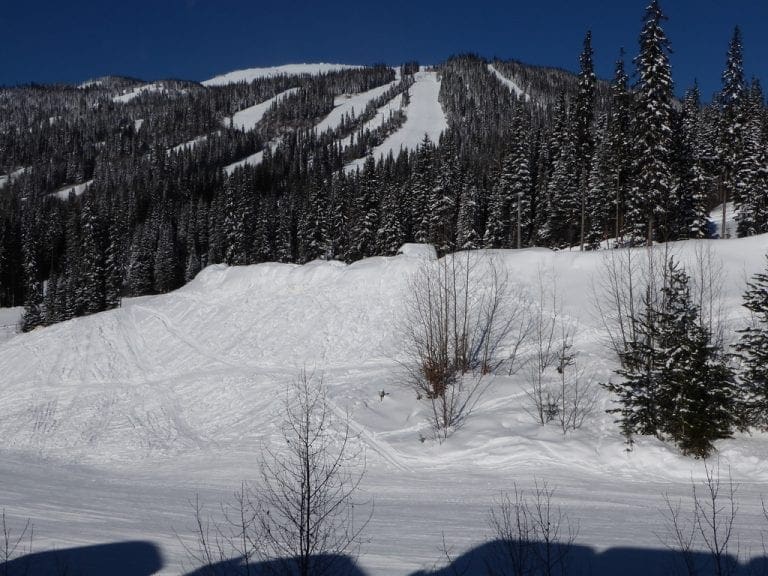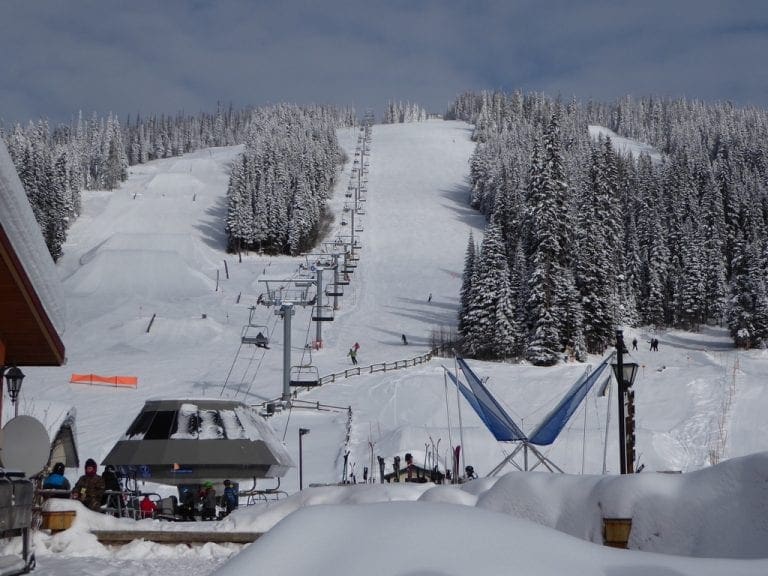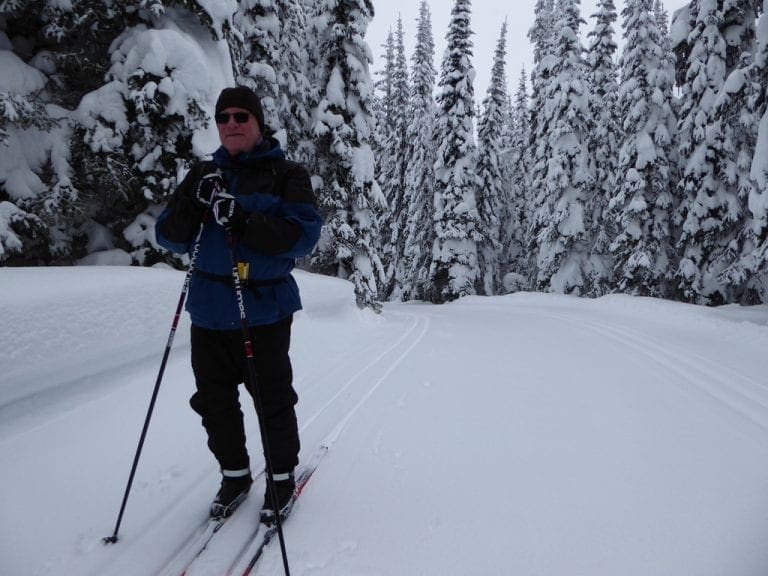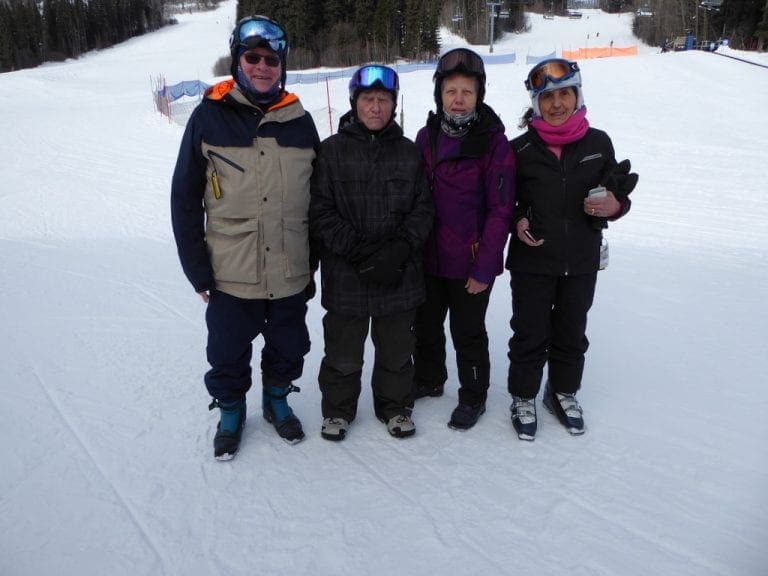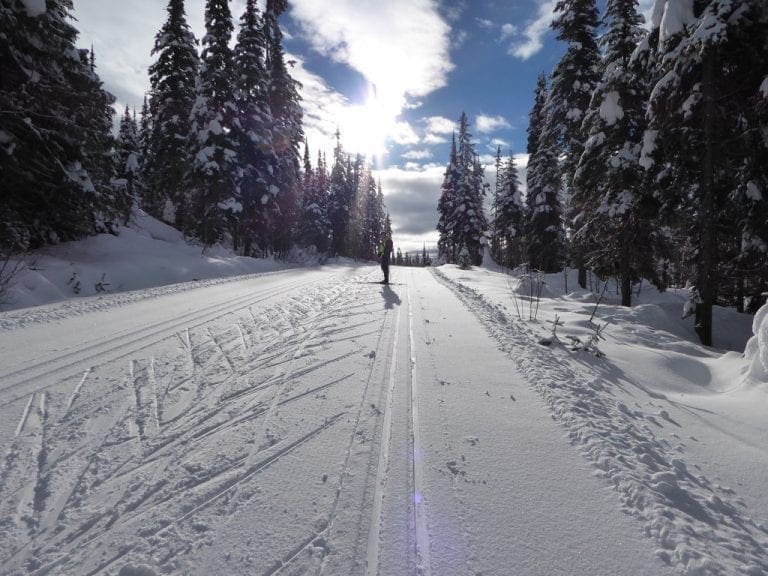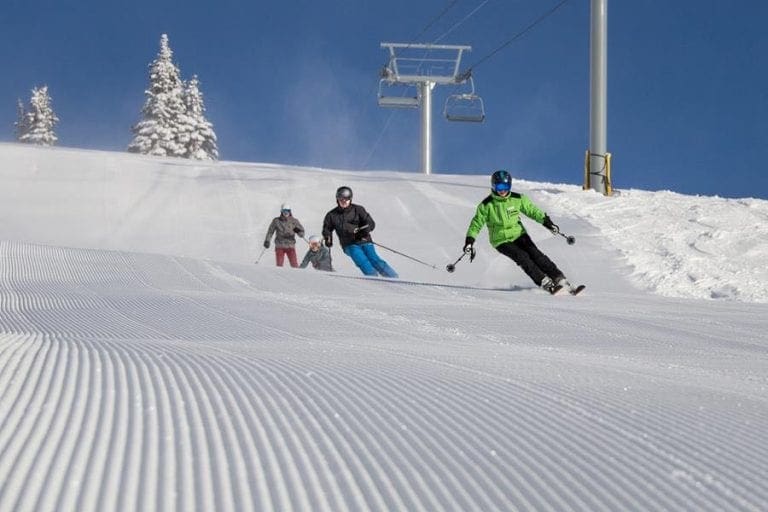Sun Peaks trip 2018 – Week 1
 |
| Sun Peaks Sunburst chair with Broadway to right Exhibition & Cruiser left |
Wednesday 17 Jan 2018. Thus begins another trip to Sun Peaks. This year, we will be staying for 7 weeks and will add downhill, resort telemarking back into our repertoire. It has been about 10 years since we have done any telemarking and I am a bit apprehensive. I don’t want to fall over. Impossible! I hear you say. We have come by XPT train from Wagga to Sydney (just less than 7 hours for the trip – which is a long time to sit in a seat) and are staying at WakeUp! which is very close to Central Station. We were in our room just 15 minutes after the train arrived at Central. A meal at the very good “It’s Time for Thai” restaurant over the road from the hostel. We have done some prep, though not as much as last year (when we were only cross country skiing). We have finally found a good gym for us in Wagga that runs good cardio and ‘pump’-like classes. Workout Wagga.
 |
| View from our room Nancy Greene’s Cahilty Hotel |
Thursday 18 Jan 2018 – which we had twice. A long 13 hour flight on a crowded 777 from Sydney to Vancouver. The night at WakeUp! was without incident and the shuttle picked us up at 8:05. An interesting fellow passenger – Chinese from Shanghai, living in France for 17 years after doing his Masters in Economics, multilingual and smart – would have liked to talk longer. Not much to say about the flight except I find those 777 seats very hard to sleep in. Very quickly through immigration at both ends and the bags checked through to Kamloops. All went without a hitch, arrived at Kamloops, shuttle up the mountain. A great greeting from the hotel’s manager and owner. Very good to see Calvin Doyle and Susan Douglas again. Bags up to the room (we have a loft this year which will give us more room), skis down to the ski room, unpacked into draws, over to the little shop for the first round of food buying. All completed by 3:30pm. Our room has a great view of the main runs off Sunburst lift and we look down on the hotel’s exit from its ski room, the bottom of the Gentle Giant run and the platter lift. Lots of very small kids skiing past. Absolutely nothing like it. This is a great place. Very much like coming home. (I think I say that every time.)
 |
| Outdoor hottub Cahilty Hotel |
Friday 19 Jan 2018 day 1 skiing. We can still do it! We did not do much. However, it was very satisfying and a real relief that we can still telemark down resort slopes. It all came flooding back. We stuck to green runs and had two runs down the beginners’ platter before taking longer runs. First, one down Sundowner and then three runs down Cahilty/5 mile. Felt very good too. By the third run, our speed had picked up considerably and we were having to work less (which is easier on the quads). Even so, we were still pretty buggered after just 3 runs down the easiest runs on the hill – 2,230m descent, max speed 38.4kph, 12km skiing. Must be getting old. Mind, my heart rate monitor says that I did an extremely big effort today and warns me not to do much for 48 hours. We slept for much of the afternoon. Quite a lot of people here at the resort – for the icewine festival. For two of our runs we actually had to line up for a chair.
 |
| Homesteader |
Saturday 20 Jan 2018. 3cm new snow overnight. I’m still recovering from yesterday and went out for just two runs – Homesteader (green) and Granny Greenes (Blue). Granny Greenes was the Groomer’s Choice for the day, however, I think it can get a bit scratchy and it is not my favourite run. I was out for only an hour. 960m descent and 5.5km distance. Max speed just 33.1kph on the first steep of Homesteader.
 |
| Homesteader |
Sunday 21 Jan 2018. Windy. First down Three Bears which was different from the way I remembered. It used to have clumps of sapling at the top. Now, they are tall trees. Steeper than I remembered as well. Then, five runs down Sundowner which was delightful. I am working less hard as I am not cutting right back across the hill on each turn. Speed is increasing. 2,800m descent. Max speed 40.5kph.
Monday 22 Jan 2018. A few more cm of snow overnight and during the day. No wind today. We skied first Sundowner which had 5cm on new snow on top of its grooming which was churned up before we got to it, then twice down Homesteader, once more down Sundowner (which was very churned up and was forming small bumps – too much for me) and one more down Homesteader. Getting much better as I am pointing much better down the hill. Looking at the bottom not the snow in front – My head has processed that already. Trust the head and the skis. 2,345m descent, max speed 42kph. Quite a good day but a bit buggered. A long sleep in the afternoon.
Tuesday 23 Jan 2018. Day off. Before we left Wagga, I bought a new Polar Heart Rate Monitor M430. It is fantastic. I can see much more about what I am doing than the old monitor with its chest strap. This one takes my heart rate from my wrist and has a good gps. So it tracks what I do 24 hours a day and shows a track of my skiing on a map, together with heart rate, speed and descent. It is also instructing me to have a day off because of the hard work on the first day. By now, I am forced to admit that it is right – I need a rest.
Our room has great views, we look down on the lower part of Gentle Giant – the easiest learners slope. We can’t see ‘Calamity Corner’ which is just up hill. Most of the day, we have a constant stream of kids on their first runs. At eye level, we can see the platter lift and moving carpet – both for beginners. (Though we use the platter to get back to our room.) At the top of the platter is also the village school which has been a major village project and now has over 120 pupils. School is Mon – Thurs with Fridays working in the village or on the slopes. Looking further up, we have an excellent view of the main runs on the front of Tod Mountain (serviced by Sunburst lift) Broadway, Exhibition, Cruiser, Blazer. Down and to the left we can almost see the loading point for Sunburst and Sundance lifts and platter. Down there somewhere is the new medical centre which has been the second major village project. The other major project has been the fire brigade.


